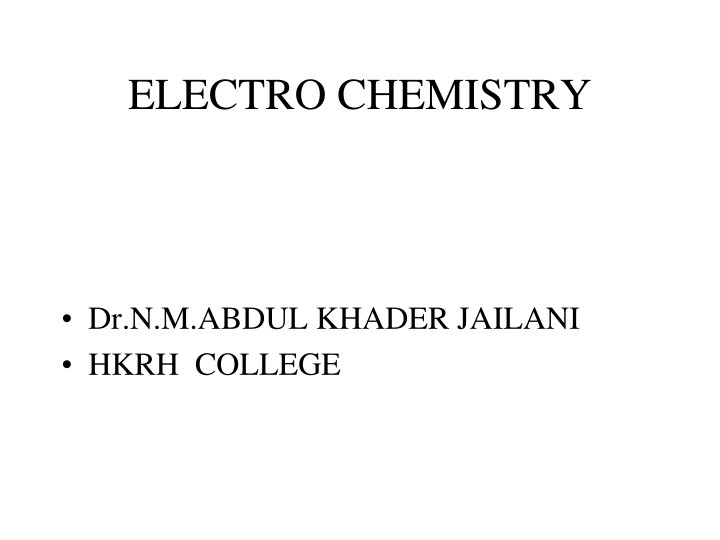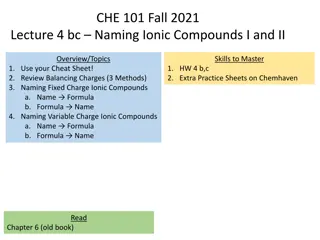
Understanding Electrochemistry and Cell Potentials
Delve into the world of electrochemistry with a focus on galvanic and electrolytic cells, cell potentials, standard cell potentials, Faraday's Law of Electrolysis, and the relationship between Gibbs Free Energy and equilibrium constants. Explore how spontaneous chemical reactions generate electrical energy and learn about key concepts such as reduction potentials, the Faraday constant, and the calculation of Gibbs Free Energy in electrochemical systems.
Download Presentation

Please find below an Image/Link to download the presentation.
The content on the website is provided AS IS for your information and personal use only. It may not be sold, licensed, or shared on other websites without obtaining consent from the author. If you encounter any issues during the download, it is possible that the publisher has removed the file from their server.
You are allowed to download the files provided on this website for personal or commercial use, subject to the condition that they are used lawfully. All files are the property of their respective owners.
The content on the website is provided AS IS for your information and personal use only. It may not be sold, licensed, or shared on other websites without obtaining consent from the author.
E N D
Presentation Transcript
ELECTRO CHEMISTRY Dr.N.M.ABDUL KHADER JAILANI HKRH COLLEGE
ELECTRO CHEMISTRY ELECTRO CHEMISTRY Electrochemistry Galvanic cells Cell Potentials and Standard cell potentials Electrolytic cells Faraday s Law of Electrolysis
Galvanic cells (also called Voltaic cells) use spontaneous chemical reactions to generate electrical energy in the form of an electrical current G < 0 e- Anode e.g. Zinc electrode Cathode e.g. Copper electrode Salt Bridge - + Electrolyte, e.g. ZnSO4 Electrolyte, e.g. CuSO4 Most batteries are made from Voltaic cells! Made up of two half cells Oxidation (loss of electrons) occurs at the negative anode Reduction (gain of electrons) occurs at the postive cathode Salt bridge acts to complete the circuit by joining the two half cells together
For the example above, the reactions occuring are: Anode: Zn(s) Zn2+(aq) + 2e- Cathode: Cu2+(aq) + 2e- Cu(s) The shorthand notation for this cell is: Zn(s) | Zn2+(aq) || Cu2+(aq) | Cu(s) Cell potentials The cell potential, E, is a measure of how well a cell reaction can push and pull electrons through a circuit The electrical energy generated by the spontaneous reaction is proportional to the cell potential. The standard cell potential (the cell potential measured when all the species are in their standard states) is given by: E cell = E cathode - E anode
The more negative the reduction potential is, the more readily the element acts as a reducing agent, i.e. is itself oxidised Reduction occurs at the electrode with higher potential and oxidation occurs at the electrode with the lower potential Unit of potential is the volt (V) and unit of charge is the Couloumb (C) These are related by: 1V = 1J/C The charge of one mole of electrons is given by the Faraday constant, F (F = 96,500 C mol-1) We can combine the standard cell potential and Faradays constant to give us an equation for G G = -n F E cell where G is the change in Gibbs Free Energy n is the number of moles of electrons F is Faradays constant E cell is the standard cell potential
Have relationship between Gibbs Free Energy and Equilibrium constant: G = - RT lnK G for a reaction depends on the concentration by: where Q is the reaction quotient = [product] G = G + RT ln Q [reactant] But G = -n F Ecell and G = - n F E cell -nFEcell = -nFE cell + RT ln Q Dividing across by nF gives: Ecell = E cell RT ln Q nF Nernst Equation i.e. the cell potential at any conditions depends on the potential under standard state conditions and a term for the potential at nonstandard- state conditions
Question Which of the following statements relating to electrochemistry are correct? (i) Oxidation involves the loss of electrons (ii) Reduction involves the gain of electrons (iii) Galvanic cells use electricity to produce chemicals (iv) The anode in a Galvanic cell is positive (v) Oxidation always occurs at the cathode Answer: (i) and (ii) Question The standard potential of the Ag+/Ag electrode is +0.80 V and the standard potential of the cell Fe(s)|Fe2+(aq)||Ag+(aq)|Ag(s) is +1.24 V. What is the standard potential of the Fe2+/Fe electrode? Half reactions Fe Fe2+ + 2e- Ag+ + e- Ag Oxidation reaction - Anode Reduction reaction - Cathode E cell = Ecathode - Eanode Eanode = Ecathode - E cell Eanode = 0.80 V 1.24 V Eanode = -0.44 V
Question If the standard cell potential at 298 K is 1.10 V for the following reaction Zn(s) + Cu2+(aq) Zn2+(aq) + Cu(s), then what is the change in Gibbs Free Energy? G = -n F E cell Half reactions: Zn Zn2+ + 2e- Cu2+ + 2e- Cu n = no of moles of electrons = 2 F = Faradays constant = 96,500 C/mol E cell = 1.10 V = 1.10 J/C G = - (2) (96500 C/mol) (1.10 J/C) = - 212300 J/mol = - 212.3 kJ/mol
Question The equilibrium constant for the reaction Ni(s) + Hg2Cl2(s) 2Hg(l) + 2Cl-(aq) + Ni2+(aq) is 1.8 1019 at 298K. What is the value of the standard cell potential E cell for this reaction? G = -RT ln K = - (8.314 J K-1 mol-1) (298 K) ln (1.8 1019) = - 109847.8 J mol-1 = - 1.098 105 J mol-1 G = -n F E cell E cell = - G n F = -(-1.098 105 J mol-1) (2 mol) (96500 C) = 0.57 J/C = 0.57 V
Electrolytic cells Use an applied voltage to carry out a nonspontaneous chemical reaction G > 0 Electric current supplied by an external source Power Supply Cathode e.g. inert Ti Anode e.g. inert Ti + - Cl- Na+ Electrolyte, e.g. NaCl External source must provide a greater potential than that for the spontaneous reverse reaction Electrolysis = process in which electrical energy is used to cause a non-spontaneous chemical reaction to occur
Electrolysis of water 2H2O(l) O2(g) + 4H+(aq) + 4e- 2H2O(l) + 2e- H2(g) + 2OH-(aq) 2H2O(l) 2H2(g) + 2O2(g) Oxidation Half-Reaction Reduction Half-Reaction Overall (cell) Reaction
Faradays Law of Electrolysis: the quantity (moles) of product formed by an electric current is stoichiometrically equivalent to the amount (moles) of electrons supplied Faradays constant Current + Time Charge Moles of electrons Using Faradays Law! Molar mass Moles product Mass product
Question If 306C of charge is passed through a solution of Cu(NO3)2 during an electrolysis experiment, what is the number of moles of copper metal deposited at the cathode? Cu(NO3)2 Cu2+ + 2NO3- Cu Cu2+ + 2e- 2 moles of electrons required to reduce 1 mol Cu2+ charge = 306 C 96500 C/mol No of moles e- = Faradays constant = 0.00317 moles of electrons From reaction stoichiometry, 2 moles electrons 1 mole Cu 0.00158 moles Cu deposited Question If 612 C of charge is passed through a solution of Cu(NO3)2(aq), calculate the number of moles of copper metal deposited. Answer = 0.00317 mol
Question How long will it take to deposit 0.00235 mol of metallic gold by electrolysis of KAuCl4(aq) using a current of 0.214A? KAuCl4(aq) Au(s) Au3+ + 3e- Au For every 1 mol Au produced, 3 mol electrons required For 0.00235 mol Au need 0.00705 mol electrons Charge No of moles electrons = Faradays constant Charge = moles electrons Faradays constant = 0.00705 mol 96500 C/mol = 680 C Time = Charge/Current = 680 C / 0.214 A = 680 As / 0.214 A = 3179 s = 53 mins Charge = current time 1C = 1As
Question How long will it take to deposit 0.0047 mol of gold by electrolysis of KAuCl4 using a constant current of 0.214 A? Answer: 106 minutes Question How much Ca will be produced in an electrolytic cell of molten CaCl2 if a current of 0.452 A is passed through the cell for 1.5 hours? Answer: 0.5 g Ca




















